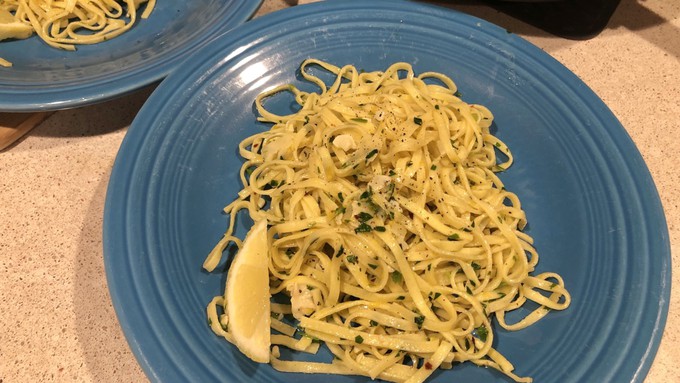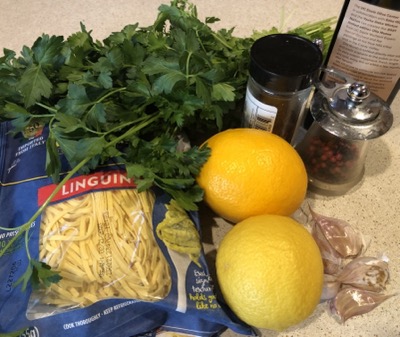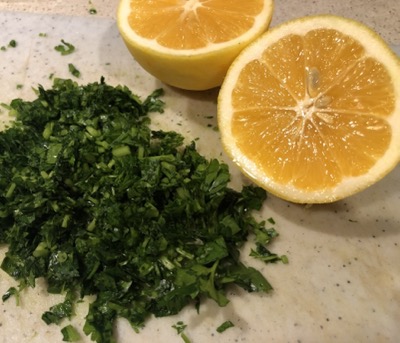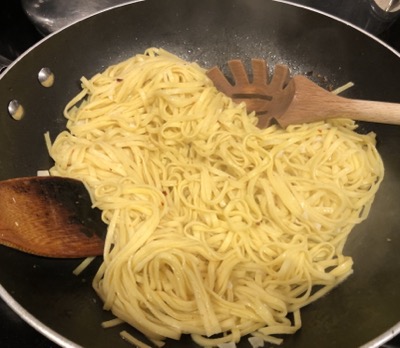
Recipe: No butter or cream in flavorful side dish

Light, flavorful and fast: Lemon pasta, made here with fresh linguine. Kathy Morrison

Anything bright and fresh is welcome these days, as winter drags into its last weeks. I found this lively citrus pasta dish while looking for yet another way to use my lemon horde.
Made without cream or butter, the pasta beautifully complements a main such as grilled fish, crab cakes or baked chicken. But I could see it as an excellent vegetarian main course -- or vegan if you leave out the Parmesan cheese.
I recommend using fresh linguine (found in the refrigerated case at grocery stores) but it also will work with dried pasta such as angel hair or thin spaghetti. The fresh packages are usually 9 ounces, not 12, so either use part of a second package, or just cook the one package -- the sauce generally will not have to be adjusted.
I've made this dish using just Meyer lemons, but I prefer the blend of zest from one Meyer lemon and one tart lemon. For juice I used the golden Meyer. And don't skimp on the garlic or the parsley. They both add depth to the sauce.
One more note: This recipe moves quickly once you start cooking, so it's important to have everything grated, chopped, etc., ahead of time and at hand.
Fresh lemon pasta
Serve 4 as a side dish or 2 as a main
Ingredients:

9 to 12 ounces long pasta, either fresh or dried (linguine seems to work best)
Salt and freshly ground black pepper
3 tablespoons good olive oil
6 garlic cloves, minced
1/2 teaspoon dried red pepper flakes, or to taste
Zest from 2 medium to large lemons (about 2 tablespoons), Meyers or tart or both
Juice from the larger lemon, about 1/4 cup
1/2 cup chopped Italian parsley
1/4 cup grated Parmesan cheese, plus more for serving
Instructions:
Put a 4-quart pot of water on to boil for the pasta. When it starts boiling, add a dash of salt, and the pasta. If it's fresh, it will cook quickly, so be prepared. Cook pasta to al dente doneness, and save out 1 cup of cooking water before draining the pasta gently and setting it aside.

In a large skillet, heat the olive oil on medium heat, then add the minced garlic and the red pepper flakes. Cook until fragrant, stirring, no more than 1 minute. Add the lemon juice and 1/4 cup reserved pasta water, then add the cooked pasta and toss, coating the pasta.
Remove the skillet from the heat and add the parsley and lemon zest to the pasta, tossing to distribute well. Add the Parmesan and, if needed, more pasta water to get the strands well-coated. Season to taste with salt and freshly ground black pepper.
Serve immediately with more Parmesan and an optional drizzle of olive oil.
Here are a few more of our citrus-with-pasta recipes:
Chill out with lemony pasta salad
Comments
0 comments have been posted.Sacramento Digs Gardening to your inbox.
Food in My Back Yard Series
May 6: Maintain soil moisture with mulch for garden success
April 29: What's (already) wrong with my tomato plants?
April 22: Should you stock up on fertilizer? (Yes!)
April 15: Grow culinary herbs in containers
April 8: When to plant summer vegetables
April 1: Don't be fooled by these garden myths
March 25: Fertilizer tips: How to 'feed' your vegetables for healthy growth
March 18: Time to give vegetable seedlings some more space
March 11: Ways to win the fight against weeds
March 4: Potatoes from the garden
Feb. 25: Plant a fruit tree now -- for later
Feb. 18: How to squeeze more food into less space
Feb. 11: When to plant? Consider staggering your transplants
Feb. 4: Starting in seed starting
Sites We Like
Garden Checklist for week of May 11
Make the most of the lower temperatures early in the week. We’ll be back in the 80s by Thursday.
* Plant, plant, plant! It’s prime planting season in the Sacramento area. Time to set out those tomato transplants along with peppers and eggplants. Pinch off any flowers on new transplants to make them concentrate on establishing roots instead of setting premature fruit.
* Direct-seed melons, cucumbers, summer squash, corn, radishes, pumpkins and annual herbs such as basil.
* Harvest cabbage, lettuce, peas and green onions.
* In the flower garden, direct-seed sunflowers, cosmos, salvia, zinnias, marigolds, celosia and asters. (You also can transplant seedlings for many of the same flowers.)
* Plant dahlia tubers.
* Transplant petunias, marigolds and perennial flowers such as astilbe, columbine, coneflowers, coreopsis, dahlias, rudbeckia and verbena.
* Keep an eye out for slugs, snails, earwigs and aphids that want to dine on tender new growth.
* Feed summer bloomers with a balanced fertilizer.
* For continued bloom, cut off spent flowers on roses as well as other flowering plants.
* Add mulch to the garden to maintain moisture. Mulch also cuts down on weeds. But don’t let it mound around the stems or trunks of trees or shrubs. Leave about a 6-inch-to-1-foot circle to avoid crown rot or other problems.
* Remember to weed! Pull those nasties before they set seed.
* Water early in the day and keep seedlings evenly moist.